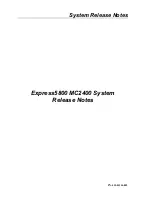
10
Figure 11 RAID 50
For any given number of drives, when the most parity groups are configured, the data loss
probability is the lowest. For example, if 12 drives are used, configuring four parity groups is more
secure than three parity groups. However, the more parity groups are configured, the less data can
be stored on the array.
Application scenarios
RAID 50 is useful in large-sized databases, file servers, and application servers.
Advantages
•
Has higher performance (especially write performance) than RAID 5.
•
Has higher fault tolerance performance than RAID 0 and RAID 5.
•
No data is lost even up to
n
(the number of parity groups) physical drives fail as long as the
failed drives are in different parity groups.
Disadvantages
•
Data is lost if a second drive in a parity group fails before data from the first failed drive in the
parity group is rebuilt.
•
More drive capacity is used for saving redundant or parity data than non-nested RAID levels.
RAID 60
As shown in
, RAID 60 is a nested RAID level combining RAID 6 and RAID 0. Member
drives are organized into several same RAID 6 logical drive groups (parity groups). RAID 60
PD
C
1
B1
A1
D
1
PC
B
2
A
2
D
2
C
2
PB
A
3
D
3
C
3
B
3
PA
QD
C
4
B
4
A
4
D
4
QC
B
5
A
5
D
5
C
5
QB
A
6
D
6
C
6
B
6
QA
S
1
S
2
S
3
S
4
S
1
S
2
Summary of Contents for UniServer B5700 G3
Page 35: ...19 Figure 29 Selecting the RAID volume to be deleted...
Page 116: ...56 Figure 96 Controller Configuration screen...
Page 220: ...61 Figure 109 Selecting Main Menu 2 Select Controller Management and press Enter...
Page 243: ...84 Figure 153 Confirming the operation...
Page 293: ...50 Figure 89 Clearing completion...
Page 382: ...21 Figure 27 Storage controller information...
Page 389: ...7 Figure 8 Identifying a storage controller 2...



































